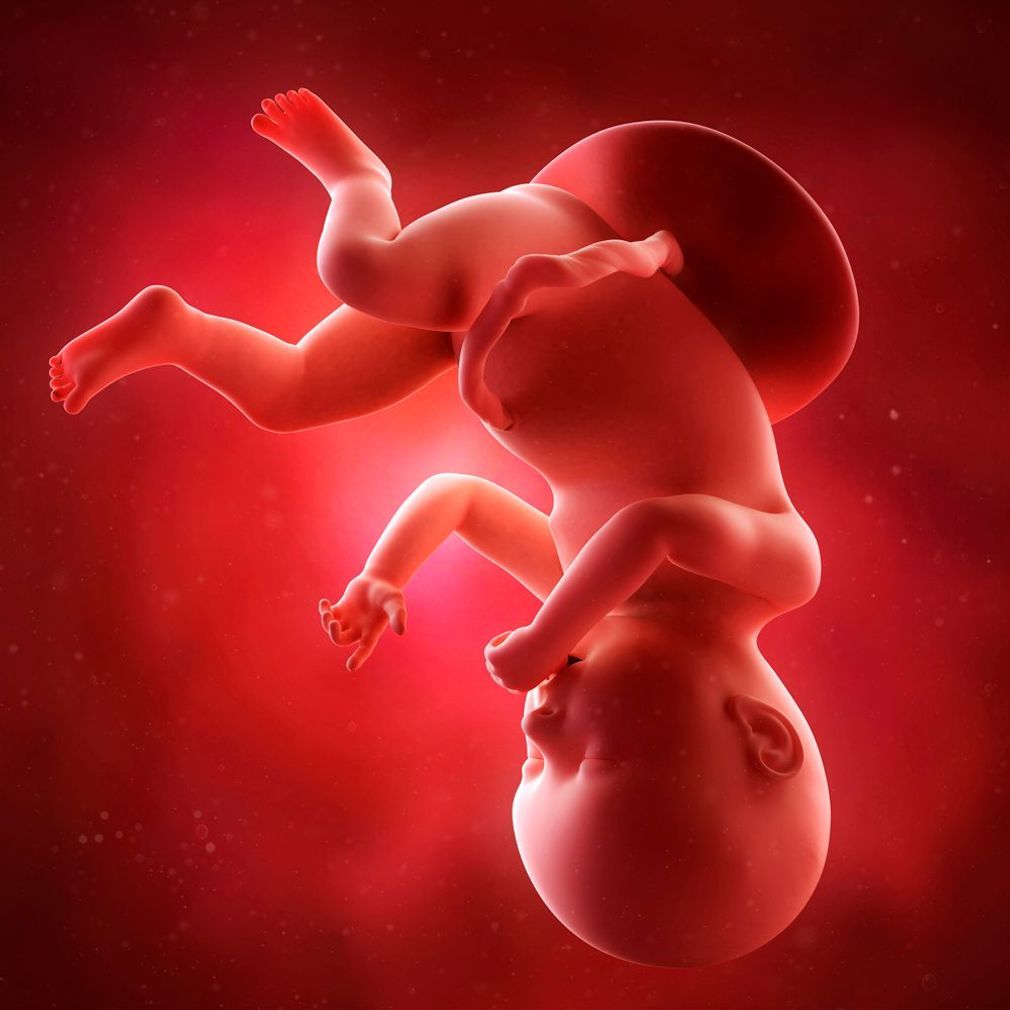Calculate the pregnancy due date of your future baby
New! More information about your future baby? So try:
New! More information about your future baby? So try:
(Amenorrhea weeks - Since the first day of your last period)
Take a rest and be patient, only days left until your due date! :-)

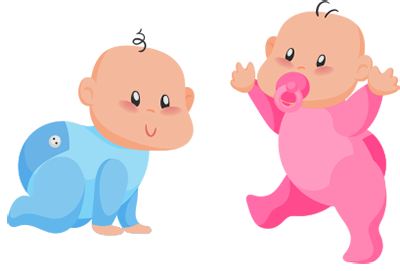


The beginning of pregnancy is the day the egg was fertilized by the sperm. You may know this day, especially if you have very regular menstrual cycles and know your ovulation date. In this case, count 266 days from the date of conception to know your due date. If necessary, the doctor can also determine the date of conception with sufficient precision using the evolution of the fetus (visible on ultrasound).
This is the most commonly used method of calculation because most women know their last menstrual day better than fertilization. To calculate the date of birth, the idea is to add 287 days the first day of your last period. These 287 days correspond to 41 weeks of amenorrhea.
Experts estimate that pregnancy lasts 280 days or 40 weeks. But some studies indicate that a normal pregnancy would actually be a little longer. For a first pregnancy, half of the women give birth after 40 weeks and 5 days, or 285 days. For a second pregnancy, it's 40 weeks and 3 days.
Some women have longer pregnancies. The same study shows that a quarter of pregnant women with their first child give birth after 41 weeks and 2 days of pregnancy. In theory, no woman would exceed 300 days, which is 42 weeks and 6 days. In fact, the doctor will usually suggest that the pregnant woman give birth between the 41st and 42nd week of pregnancy, as the risk of continuing the pregnancy would be greater than the risk of giving birth.
There are two main methods to estimate the progress of your pregnancy: the calculation of pregnancy weeks or the calculation of amenorrhea weeks. By pregnancy week, we mean "actual pregnancy week": i.e. the calculation begins on the day of fertilization. Amenorrhea weeks count the number of weeks without a menstrual period, so from the first day of your last menstrual period.
This difference between the calculation methods results in a two-week difference. In total, a "normal" pregnancy of 9 months is equivalent to 39 weeks of pregnancy or 41 weeks of amenorrhea. Useful information to determine your due date!
To calculate your pregnancy week, you must count the weeks that have elapsed since the supposed day of fertilization. If you have very regular 28-day cycles, your ovulation usually occurs on the 14th day after your period begins. Your fertility period then extends between the 10th and 15th day of the cycle (four days before ovulation and one day after).
You can refine the result depending on the date of your intercourse, but in practice, determining the exact date of fertilization is impossible for most women as they don't know the day of their ovulation. That's why doctors usually prefer to calculate weeks of amenorrhea: just count the weeks since the first day of your last period. This date is much easier to know than your ovulation!
The majority of doctors and midwives used the Naegele rule to calculate the expected date of delivery. Basically, this rule consisted of adding 7 days to the first day of the last menstrual period, then to 9 months.
However, this situation was problematic, as not all months had the same number of days, which theoretically varied according to the length of the pregnancy. For example, for a woman whose last period occurred in May, the pregnancy lasted 283 days, while it lasted only 280 days for a woman whose last period began in June. Now, professionals will say instead that the expected date of delivery will be 40 weeks after the first day of the last menstrual period.
The doctor or midwife calculates the first 2 weeks after the last menstrual period in the number of weeks of pregnancy, even if the mother was not yet pregnant. Thus, when we talk about "20 weeks of pregnancy", we refer to the 20 complete weeks that have elapsed since the first day of the last menstrual period.
An ultrasound done in early pregnancy would be more accurate than the first day of the last menstrual period to determine the due date. This is especially true if the ultrasound is performed between 8 and 16 weeks of pregnancy. The gynecologist then measures the height of the baby, from the top of his head to the buttocks. As babies develop very similarly in early pregnancy, it is then possible to make a connection between this measure and the duration of the pregnancy. The accuracy of this measurement may, however, vary from ultrasound to ultrasound.
If the date calculated using Naegele's rule differs from that determined by ultrasound by more than 7 days, the physician may choose to change the expected date of delivery to reflect the outcome of the first-trimester ultrasound. If the ultrasound is performed between 12 and 20 weeks, the difference should be more than 10 days for the doctor to consider changing the date.
The first trimester extends to the 14th week of pregnancy. The embryo begins to form. His first organs appear and his heart starts to beat. At the end of the first trimester, even if he is only 9 centimeters long, his head, trunk, arms, and legs are clearly visible. Here are the main stages of its development, week after week.
It is difficult to know the exact day of fertilization. To assess the duration of pregnancy, doctors use the number of weeks without menstruation (amenorrhea). The calculation of the due date, therefore, begins on the first day of the last menstrual period. This calculation method adds 14 days to the duration of the pregnancy. With this calculation method, you are not pregnant for the first 2 weeks.
Ovulation is the time when one of the ovaries (left or right) expels an egg. In general, women ovulate 14 days before menstruation, but this can vary from 11 to 18 days depending on the length of the menstrual cycle. The expelled egg descends along the fallopian tube, the site of fertilization. He then moves towards the uterus.
The life span of the egg is from 12 hours to 24 hours. The fertility period lasts about 5 days a month: from 4 days before ovulation to 24 hours after ovulation. Sperm cells can live for 3 to 5 days in a woman's body.
A father's sperm enters the mother's egg: they fuse to become an egg composed of a single cell. This is the fertilization and the effective beginning of pregnancy.
It will take several months for this egg to develop and become a baby. However, it contains all the genetic baggage of the child to come: his sex, the color of his eyes, his height, the pigmentation of his skin, etc. All of this in a small sphere the size of a pinhead! During its first few days of life, the egg slowly travels through the fallopian tube to implant in the uterus. During this journey, the egg, a single cell, will divide into 2 cells. These will, in turn, split to give 2 more. These 4 cells will do the same to give 8, and so on. This process is called cell division. Thus, little by little, all the organs, limbs and systems that make up a human being will be formed.
In rare cases, the egg will implant itself outside the uterus, mainly in a fallopian tube. This is called an ectopic pregnancy. Pregnancy must be stopped to protect the mother's health.
The "identical twins" come from the same fertilized egg that has completely separated into 2 embryos. They share the same genetic code and their physical similarity is impressive. These will necessarily be children of the same sex. As for the fraternal twins, they are due to the fertilization of 2 eggs. Their sex may differ.
The fertilized egg attaches itself to the mucous membrane. This step is called nesting. It lasts a few days and requires the production of a special hormone produced by the egg: the chorionic hormone gonadotropin (HCG). That's what pregnancy tests detect. HCG levels double every 2-3 days at the beginning of pregnancy to reach a peak between 8 and 10 weeks.
The presence of this hormone ensures a high production of progesterone. Its purpose: to hold the thickened mucosa in place. The egg nests deeper and deeper into it. It is entangled to feed itself (in nutrients and oxygen) thanks to the many blood vessels that can be found there.
What does the egg look like at this stage? Its size is about 1.5 millimeters. It contains several cells and has the bumpy appearance of a raspberry. It consists of two layers: an inner part that will form the embryo and an outer part that will become the placenta, the envelope used to protect and nourish the embryo. But already, the first stage of the nervous system is in place.

During this week, the embryo unfolds: it goes from a round shape to an oblong shape. It looks like a little hippocampus. Helped by the blood circulation, the embryo grows a lot during this week and it is now visible to the naked eye. The heart has begun its first stage of development. Gradually, the face appears: eyes, nose, mouth, ears.
Cells specialize. They are organized into 3 groups. Each will constitute different parts of the baby's body: skin, eyes, ears and nervous system (ectoderm), muscles, skeleton and blood vessels (mesoderm), digestive system, pancreas, and lungs (endoderm).
The umbilical cord now connects the embryo to the mother. It ensures that the embryo will receive nutrients from its mother's diet and oxygen. The cord also allows evacuating part of its waste. Nestled in the uterine cavity, the embryo is immersed in amniotic fluid.

During this week, 4 weeks from the time of fertilization, a significant part of the embryo will be completed: the neural tube. This is important because the entire nervous system develops from this structure: the brain at one end of the tube, as well as the spinal cord and nerves. The ends of the tube will close at the end of the week. Taking folic acid supplements before and during pregnancy is one of the ways to prevent malformations during neural tube formation, such as spina bifida.
It is also from the 6th week that the embryo's heart begins to beat! During an ultrasound, it is possible to observe the beats. But this little heart is still in formation: it looks like a small lump and we can see it prominently in front of the embryo's body.
The embryo looks like a bean from which small buds emerge that eventually form the arms and legs. The neck is also taking shape. The crystalline lens of the eyes and the inner ear begin to develop, as well as certain organs: lungs, stomach, liver, and pancreas.
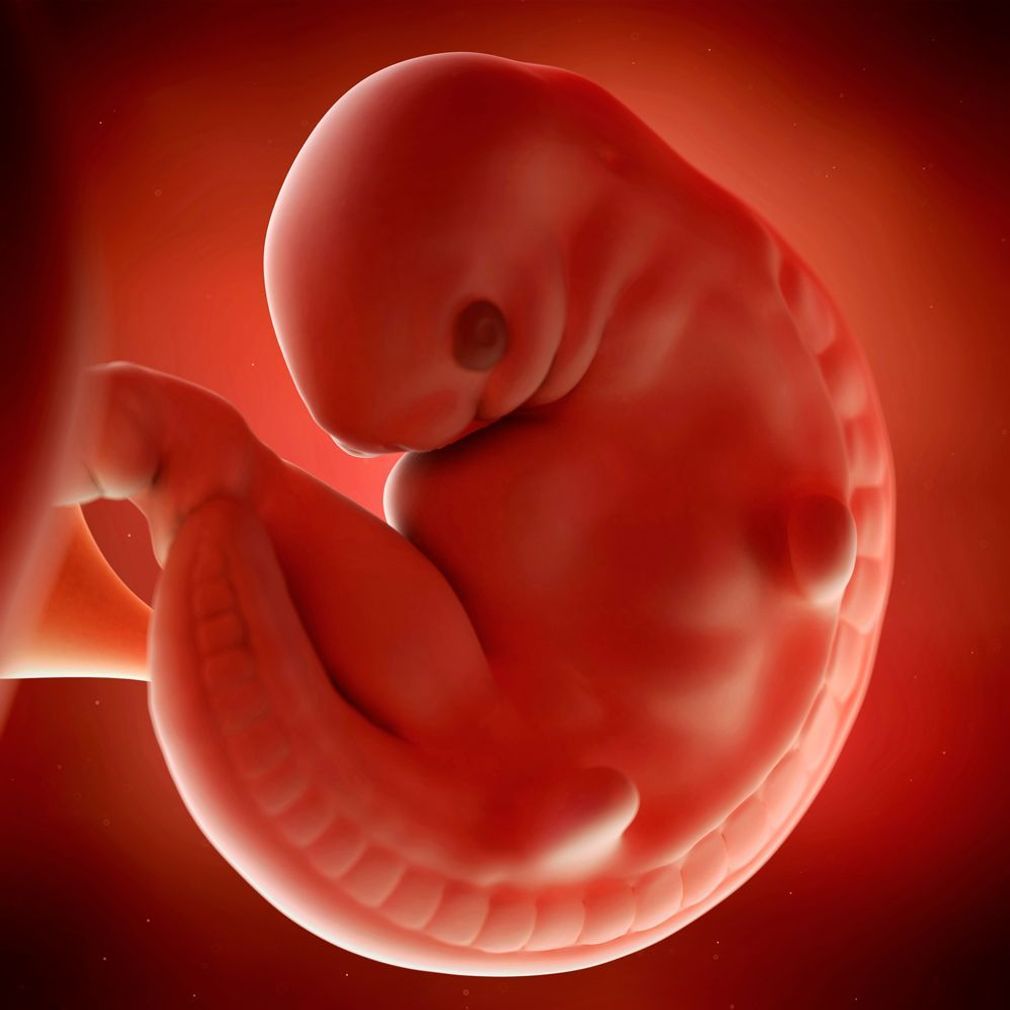
This week, brain development will take precedence over everything else! A first draft of the cortex is sketched with the development of the two hemispheres, the cerebral cortex, and the grey matter.
The head is gradually forming. The back of the brain widens, causing the embryo's head to tilt forward.
On his face, we can now see the nostrils. The gum groove, where the baby teeth will grow, is already formed. On either side of the head, we see two dark areas: these are the eyes! The retinal pigment will give them this color.
Vital organs all develop. However, they are not yet functional. We can now distinguish the 4 cavities inside the heart.
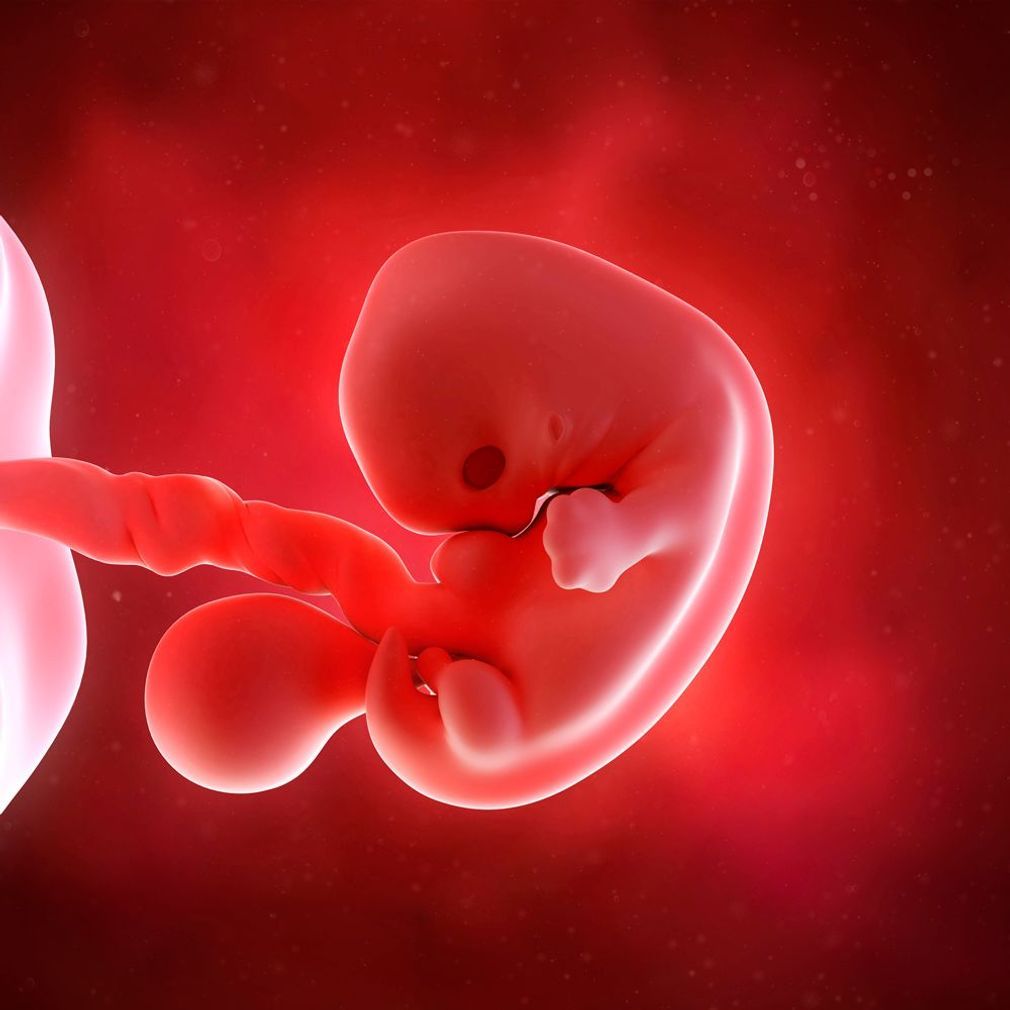
It is now the eyelids and outer ears turn (they look like small dimples) to begin their development. However, the first senses to "wake up" in the embryo will be smell and taste. At this stage, the nose and upper lip are already formed. From this week onwards, olfactory receptors will appear.
At the end of the limbs, we see small buds. They will form fingers and toes. We also distinguish the location of elbows and knees. The embryo is no longer static: it moves the trunk and limbs. It moves inside the uterus, but we don't feel it.
Several vital organs take shape: the stomach, intestine, pancreas, and kidneys appear. However, they are not yet functional.
At the end of this week, the embryo measures 11 to 14 mm.
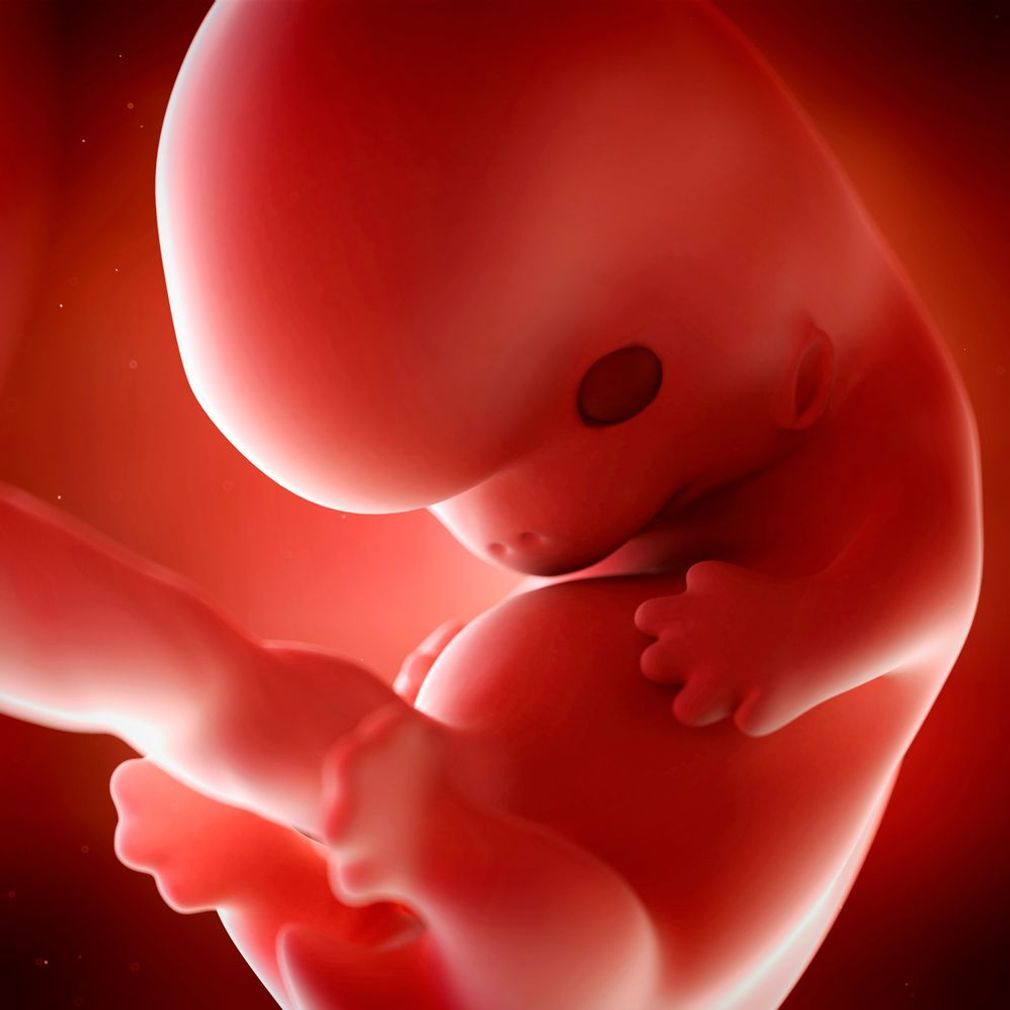
During this week, the arms and legs lengthen and the joints (elbows and knees) are more defined. We also see the wrists and ankles drawing. Inside, muscles and nerves take shape.
The head is still large compared to the rest of the body. But it gradually rounds upwards and the neck straightens up. There are two dark areas in the eyes (they are far apart on the sides of the head), 2 dimples for the ears and only one opening for the nose and mouth.
At the sensory level, touch receptors (tactile receptors) are now found around the embryo's mouth. During this week, the first taste cells will also develop.
Depending on the gender, the ovaries or testicles begin to form. However, it is only in the third month of life that the genital organs will appear.The embryo looks more and more like a baby. Its limbs have continued to grow: all parts, including the joints, are visible. Toes and fingers are well defined. The embryo can now make a whole series of movements!
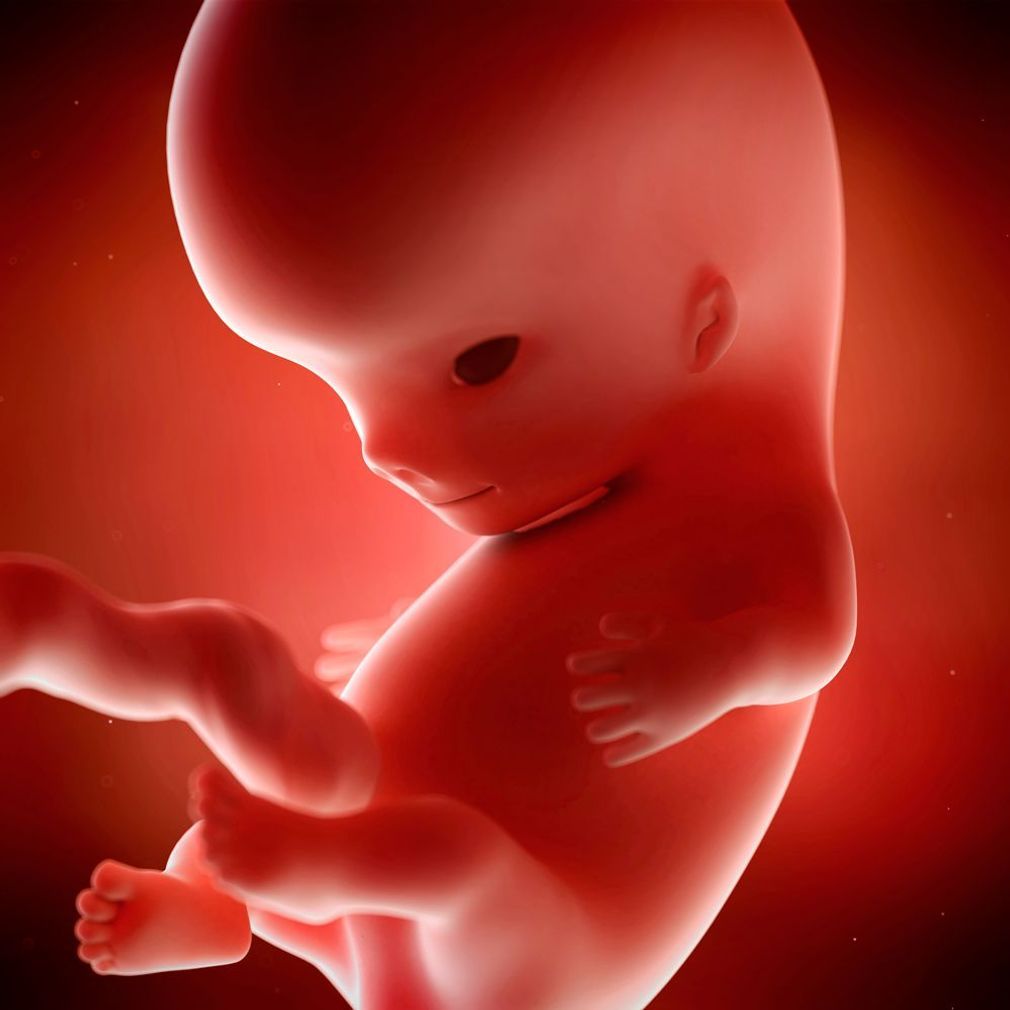
The eyelids are now formed and protect the forming eyes. The ears (external) are now very similar to yours! However, they are still located a little lower on the head, near the neck.
At this stage of pregnancy, the embryo's heart rate is at least 130 beats per minute, but it can reach 160 beats per minute. It will decrease slightly and gradually during pregnancy. Heartbeats can be seen using a Doppler, a device that allows you to hear the baby's heartbeat.
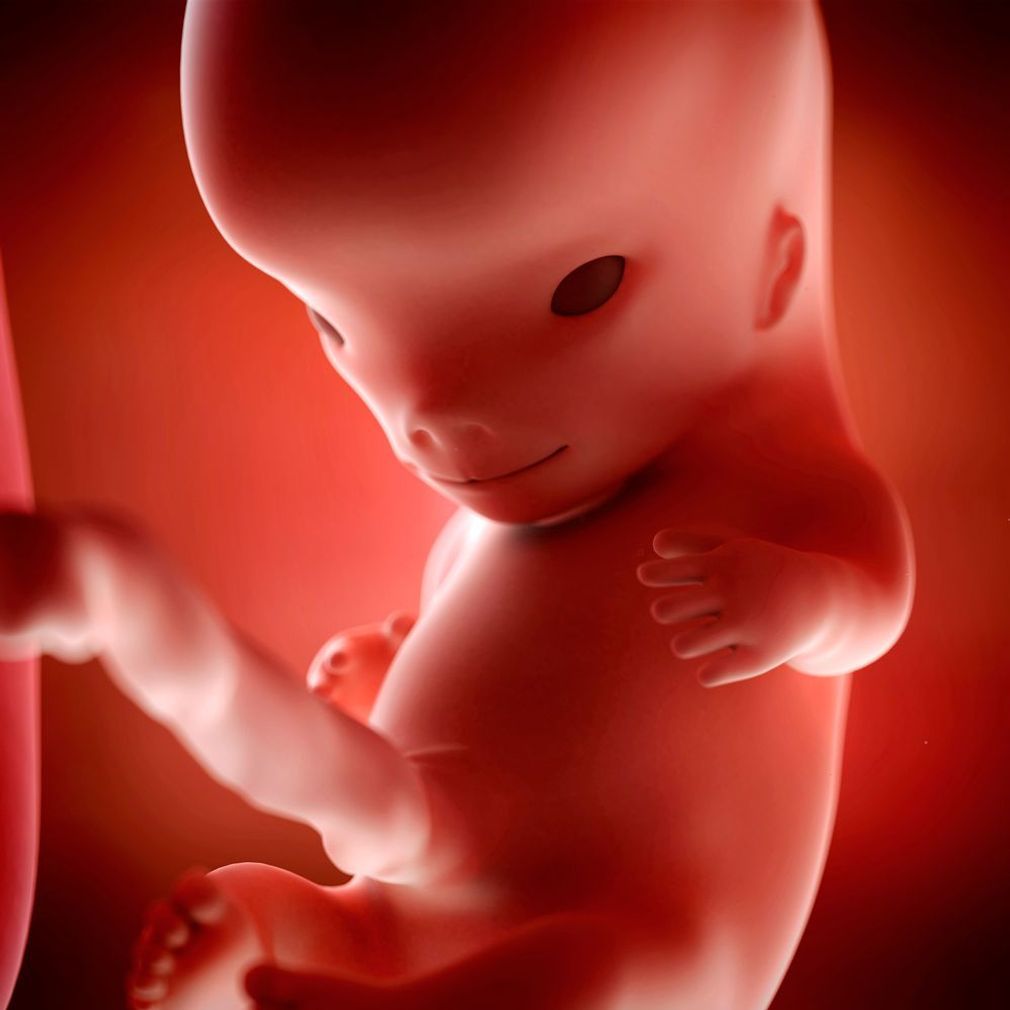
An important step has been reached: the embryo has become a fetus! His head is still bulky compared to the rest of his body. It will continue to grow but its growth will now be slower than the body's
The face is now easy to spot. The eyes migrated from the sides to the front of the face. The eyelids now cover the eyes. The lips are well defined and the fetus can open the mouth. He even drinks amniotic fluid. Fortunately, his kidneys and the urinary system started working. They filter the swallowed liquid and release it into the bladder as urine.
In the mouth and nose, the first cellular structures were transformed into taste buds and smells. The same applies to the salivary glands. And this week, the vocal cords will also begin to develop.
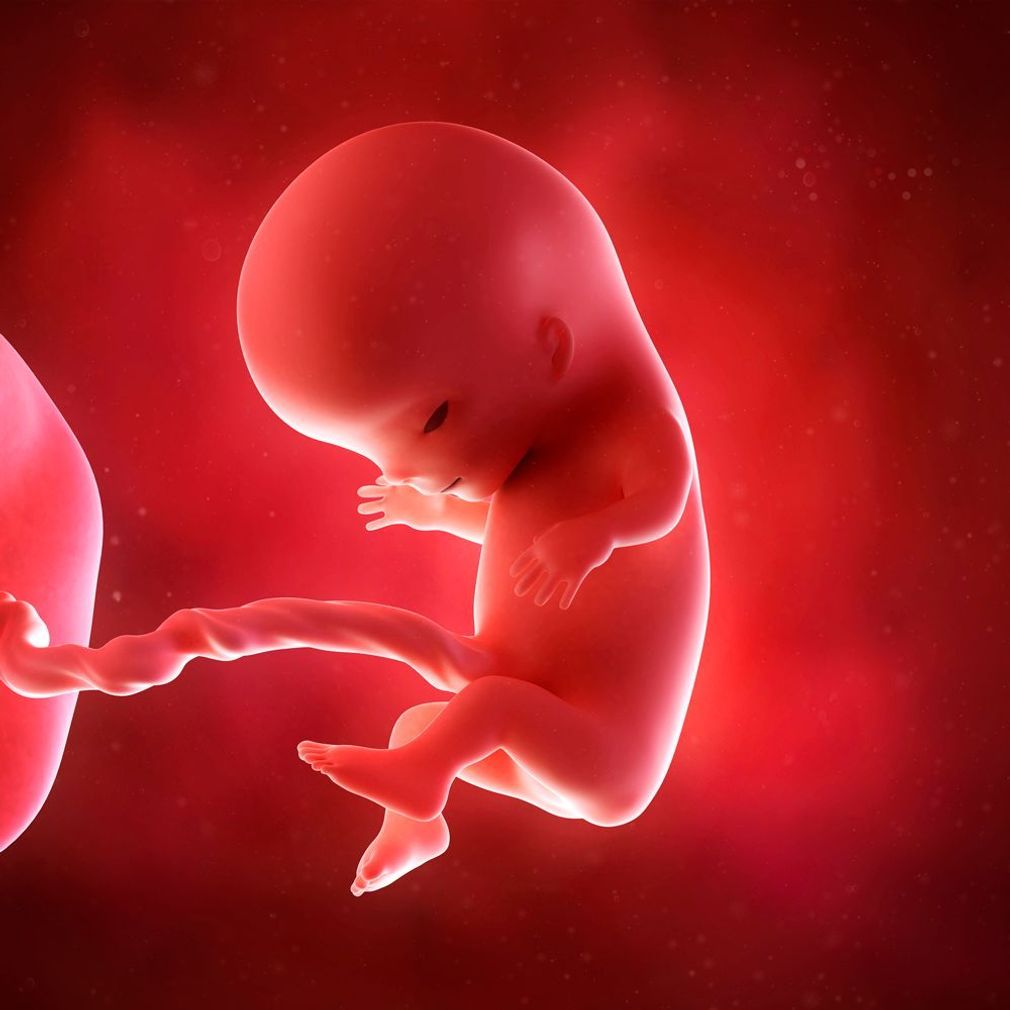
All vital organs and systems are now partially formed. The extremities are also refined: the nails begin to develop. Until then, part of the small intestine (the intestinal loops) overhangs the umbilical cord. All this is now well inside the fetus' belly.
In the brain, nerve cells multiply. They connect by creating many synapses. There are already archaic reflexes. For example, the fetus bends his fingers and toes if something touches the palm of his hand or the sole of his foot. The newborn will keep this reflex for a while, then it will gradually disappear, just like other archaic reflexes. These reflexes reflect the baby's good neurological development.
The fetus now measures 6 cm from head to the coccyx and weighs about 14 g.
The entire uterus is now occupied by the amniotic sac: ideal for your first ultrasound scan! At the end of the week, the risk of miscarriage decreases considerably. If you haven't already done so, you can start spreading the good news around you!
Throughout pregnancy, the baby baths in a liquid called amniotic fluid. This liquid is vital. It is surrounded by a thin membrane that creates a real closed pocket in the uterus. This ensures that the baby enjoys a stable temperature and can move while being protected from shocks and infections. The amniotic fluid also provides water and some nutrients. But most nutrients come from the mother's blood and the umbilical cord. At the time of delivery, the "water pocket" is pierced. It then contains about 1 liter of liquid.

The first bone tissues begin to form, including those of the pelvis, ribs, head, and limbs. They are, however, rather soft. The spine also develops gradually.
At the same time, the buds of the baby teeth appear. Under the milk teeth will grow the adult teeth. These will form later in pregnancy, in the second trimester.
The fetus' blood is formed: the bone marrow produces its first red blood cells.
The fetus' thin skin is covered with small thin hair: it is the lanugo. It usually disappears before birth. The skin pigments (which give it its color) also develop. Until then, the skin was almost transparent. Moreover, the tactile receptors now cover the entire face, the palms of hands and feet.

His face is coming to life! Some characteristics are defined as nose and mouth. The ears have taken their position on the side of the head. The fetus is also able to make certain facial expressions such as frowning and grimacing. These are mainly reflex reactions at this stage. Another distinctive element of your unborn baby appears: fingerprints.
The fetus begins to react to external stimuli. If you press on your belly, the fetus may react by pushing in turn. At this stage, it is also likely that he has started sucking his thumb.
The sex of the baby will become apparent this week or next week. For girls, ovarian follicles form; for boys, the prostate becomes visible. At your next ultrasound, you will know the sex of your future baby if you wish.
At the end of this first trimester, the fetus measures 9 cm from head to the coccyx. It weighs about 40 g.
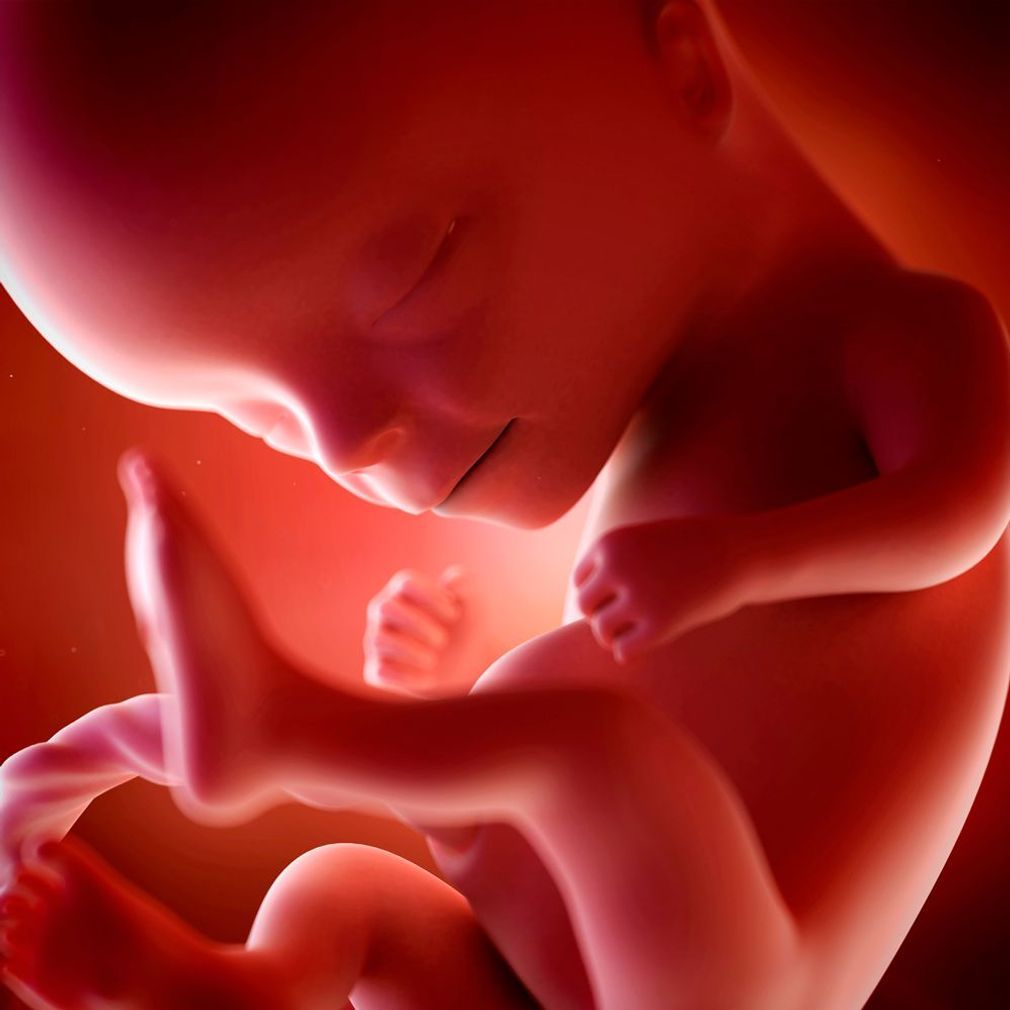
During the 2nd trimester, the baby's growth will accelerate dramatically. His presence is more realistic. He moves and his movements are well felt. His senses are awakening. The mother's womb is growing. At the end of the 2nd trimester, the fetus will measure about 25 cm from head to the coccyx and weigh about 1 kilogram.
Fifteen weeks after fertilization, the fetus begins a period of accelerated growth. Everything is now in place so that each organ can begin to do its job. There is one notable change: his legs are beginning to be longer than his arms.
The network of blood vessels becomes more complex. The heart works steadily, to irrigate this small body in development: it pumps about 24 liters of blood a day and beats at about 140 beats per minute.
His lungs are training to breathe. Through small breathing movements, it "inhales" and "exhales" the amniotic fluid. This contributes to the formation of pulmonary alveoli.
The fetus is getting more and more mobile. For example, he can now turn his head. It measures 3.5 cm. Since he still has a lot of space to move and his movements are very small, it's normal that you don't feel them yet. It will happen!
A great idea: let your future baby "taste" your favorite dishes. The gustative cells are operational around the 13th week. Your diet, through the amniotic fluid, gradually leads the fetus to discover new flavors!

Baby has more strength, and his kicks are more vigorous!
His movements are also better coordinated. When he touches the umbilical cord, he reacts first by moving away. But soon, the cord will be a "toy" for the fetus: he will grab it, pull it, push it back, etc. His little hands are getting more agile.
Under the fetus' eyelids, the eyes begin to move. And to hear his heart, an ordinary stethoscope of good quality may be enough. His little heart still beats very quickly: 110 to 120 beats per minute (about twice as fast as an adult's).
Since the fetus drinks a lot of amniotic fluid (400 ml per day), he often has hiccups. That's normal. Moreover, its digestive system begins to produce a blackish substance, meconium, which accumulates in its intestines.
At the end of this week, the fetus measures 12 cm from head to the coccyx.
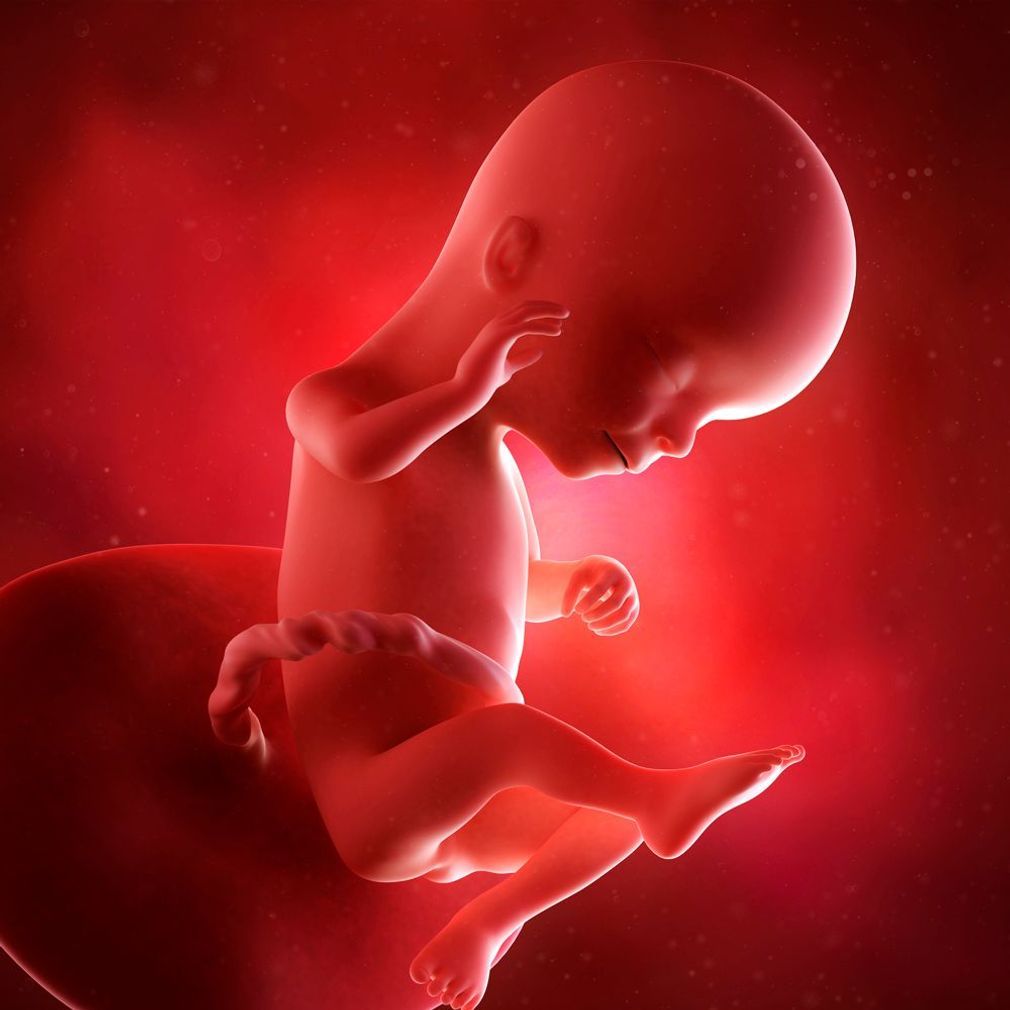
Inside the fetus' body, fat is beginning to form. This is an important step. This fat (called brown fat) will allow the fetus to stay warm once in the world since the newborn does not yet have the reflex to shiver. This supply will also provide him with energy in the early stages of his life. The fetus also begins to develop antibodies.
After the 17th week, nothing new will appear, although several stages of development continue. The skeleton is growing, but it is still made of rather soft cartilage.
His hair is slowly making an apparition.

At the beginning of the 5th month, the proportion between the head and the body has changed: the head is now smaller than the rest of the body.
The blood circulation now reaches the extremities, which means that the fetus moves a lot more! He moves around in the womb, turns around, shakes his arms and legs, touches his toes, his face, etc. You can feel very slight movements similar to a small wave.
Moreover, a fatty sheath (myelin) is formed around the nerves and protects the nerve fibers (just like a plastic sheath around a wire). It is used to control nerve impulses, i. e. the information exchanged between the central nervous system (brain and spinal cord) and the peripheral nervous system.
Soon, it will be the turn of the central nervous system cells, especially those in the brain, to be enveloped in myelin. This will be a sign that links are being created and that neural networks are being consolidated.
The retina is now sensitive to light. If a strong halo of light is projected on the mother's womb, the fetus will turn away and cover his eyes.
Ultrasound is done between 18 and 20 weeks. The main function of this examination is to ensure that his organs (heart, kidneys, central nervous system, etc.) develop properly. It also makes it possible to determine the sex of the baby, because if it is a boy, the penis is now visible. The fallopian tubes and the uterus are in place for the little girls.
At the end of the 18th week (or the 16th week of fertilization), the fetus measures about 14 cm from the head to the coccyx and weighs around 200 g.

Half of the pregnancy is now behind you. This week, there is a major change: in the fetal brain, the specialized areas of the 5 senses are being set up. The fetus will begin to process the sensory information he receives. A world is opening up for him!
Neural production slows down. The next step is to create and consolidate multiple connections between the neurons in his brain. The learning process begins.
This week, the skin becomes spotted with greasy and waxy white patches: it's the vernix. Its role is to protect the delicate skin of the fetus against friction and irritation.
Despite steady growth, there is still enough room to move his arms and legs.
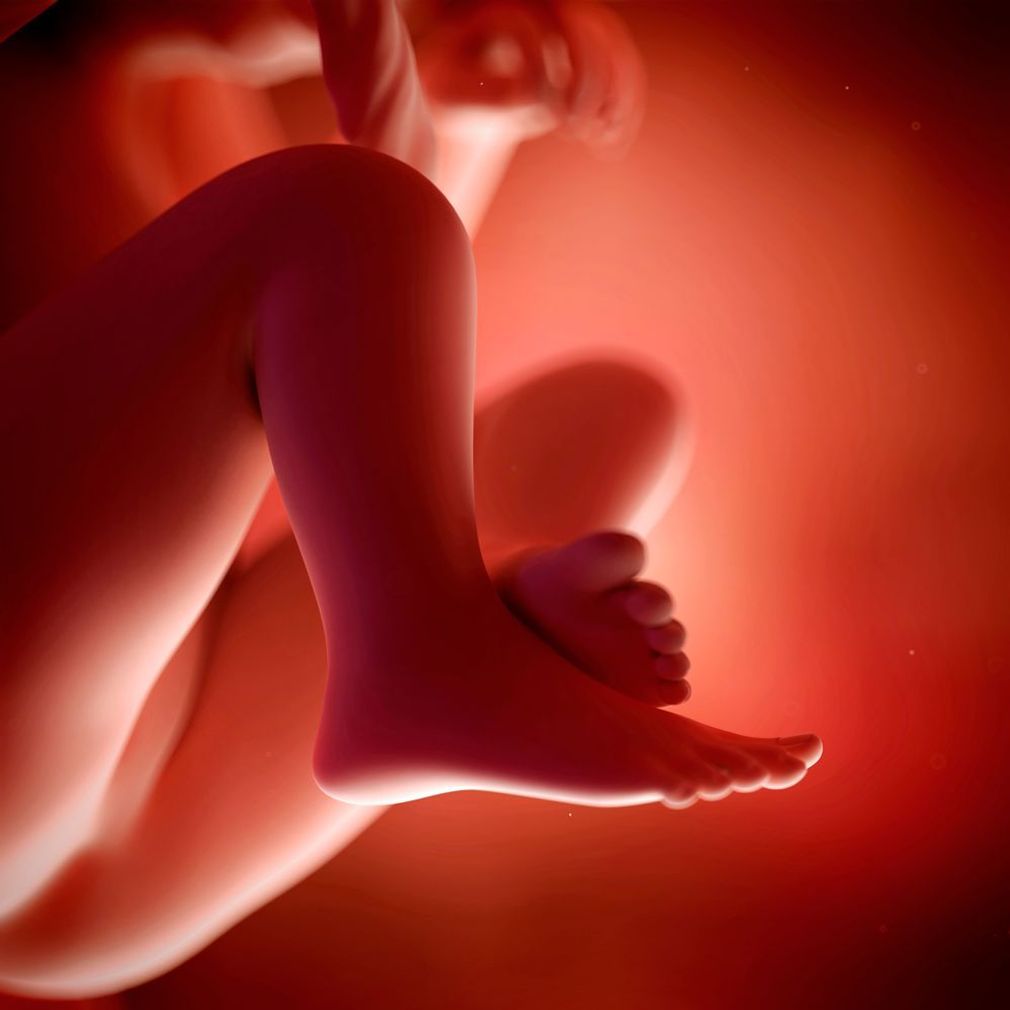
In your belly, the fetus trains to move all parts of his body. His muscles gain in volume and power. You may have noticed this because it is usually around this time that most mothers feel the baby's movements, which become more vigorous. Between periods of activity, the fetus still sleeps a lot: from 18 to 20 hours a day.
The skin of the fetus thickens even if it is still quite transparent. In his brain, the first furrows deepen.
At the end of the 20th week (or 18th week of conception), the fetus measures 16 cm from the head to the coccyx.

The fetus is now completely formed. During the next month, he will continue gaining weight.
He is more and more familiar with touch. He grabs his feet and joins his hands. He sometimes puts his thumb in his mouth and likes to play with the umbilical cord.
The lungs continue their long maturation. The fetus exercises to inflate the chest muscles that will be used to breathe once outside the uterus.
Its eyeballs are formed, but the iris does not yet have a color (pigmentation). His lips are more fleshy. He now has more hair.

The fetus's body begins to regulate its blood sugar level. Thanks to the pancreas that now secretes insulin. The fetus already likes the taste of sugar. When the amniotic fluid is sweeter, he will drink more.
Even though the fetus is gaining volume, his fat supply remain limited. Also, his skin is still wrinkled: it will stretch as the fetus will gain weight.
During this second half of pregnancy, brain development is in full swing! In the gums, the permanent teeth buds begin to develop, behind those of the milk teeth. The teeth will be ready to come out in the months following the birth.
At this stage, the fetus measures 19 cm from the head to the coccyx and weighs 460 g.

His body is now covered with vernix caseosa (oily and waxy white spots). This protection is necessary as the concentration of urine in the amniotic fluid is increasing. As birth approaches, this protective layer will gradually disappear. The remaining thin layer will be used to facilitate delivery.
At the beginning of the 6th month, muscle development is at its peak. You may notice that the fetus has a movement "routine", which means the fetus will make movements at a certain time during the day. It's a good sign. You should stay attentive to his movements.
He's also starting to open his eyes! His eyelids are gradually coming off. In a few weeks, he will perform some eye movements. He becomes aware of light and darkness.
For boys, the testicles descend gently from the belly to the future scrotum (they will remain in the inguinal canal until the 9th month). As for girls, the reproductive system is in place, including the eggs.

The immune system is now producing white blood cells. Thanks to these cells, the body is able to fight against diseases and infections.
The fetal skin thickens and colors slightly, although it is still quite transparent. Blood is still present in the blood vessels (capillaries).
On the fetus's head, real hair started to grow, but that's not it. On his fingers, nails now appear more clearly.
During this period, weight gain is important. It now weighs more than 630 g and measures 21 cm from the head to the coccyx. From now on, the fetus fills pretty much the space of the uterus.
If born at that time, 22 weeks after fertilization, the fetus could survive, but he would need ultra-specialized care. At this stage, he would be considered as extreme preterm as his respiratory and digestive systems are not mature yet.

The fetus begins to recognize certain elements or situations: the familiar voice of his mother, other family members, activity and daylight, the tranquility of the night, etc. Sometimes he jumps out of surprise and sometimes he can respond to small touches he receives from the outside. In short, he has a certain awareness of your presence.
The fetus also reacts to the sounds of your body. He hears your heartbeat, the air entering your lungs, digestive noises, etc. All these sounds calm and rock him. It is not surprising that when you snuggle him in your arms after birth, he calms down. He will feel reassured by all the noises he heard when he was in your belly.
You can now see the movements of your future baby on your stomach. During his waking periods, he is very active! It can do 20 to 60 movements per half hour.
The development of the bronchi is almost complete, but the lungs have not yet reached full maturity.
The eyes gradually take on their color (pigmentation), although this will change after birth. The ivory that will protect the enamel of the baby teeth begins to form.
Depending on the fetus' position, you can hear his heart simply by placing an ear on your belly.
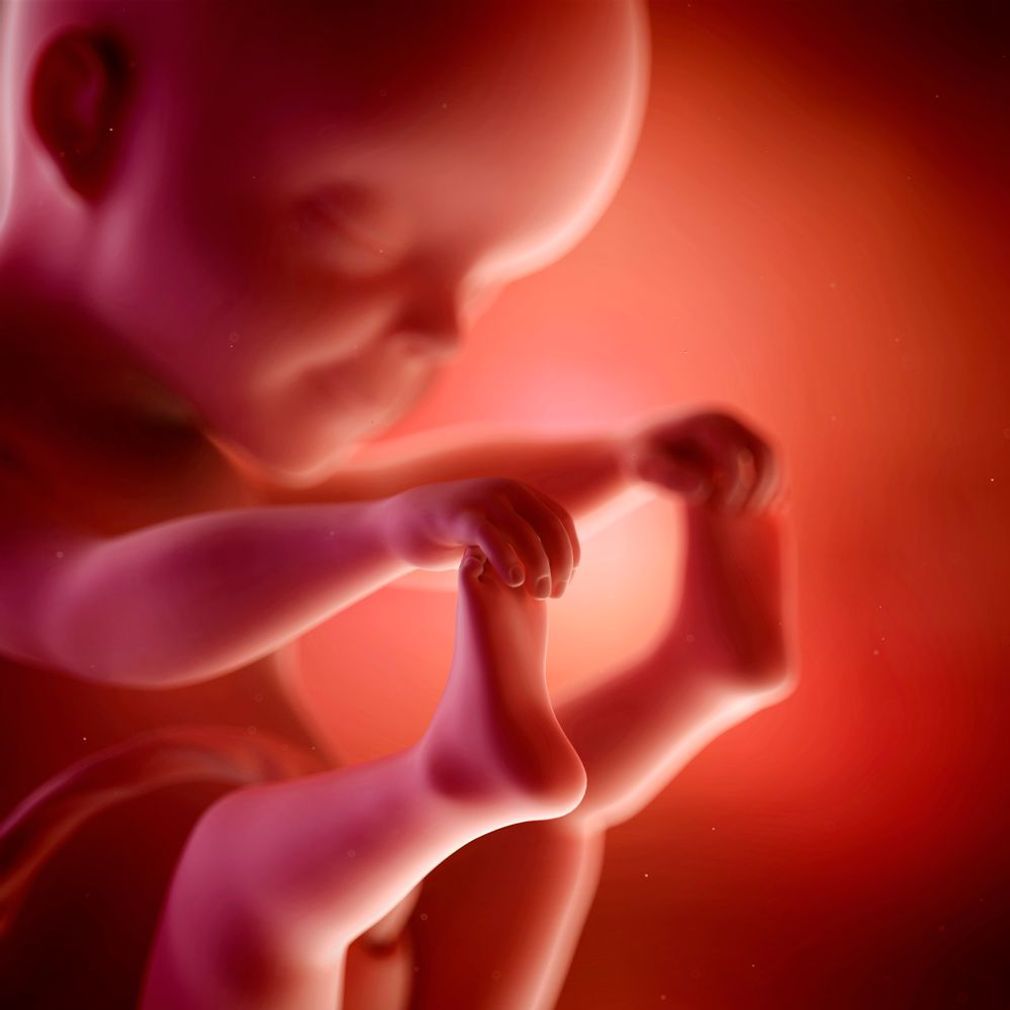
This week, the development of the lungs takes a step forward, which is particularly important for the fetus that would be born prematurely. Lungs begin to secrete a substance that allows them to expand more easily. It also protects against infections, which increases the baby's chances of survival.
The features of his face are more precise: his eyelashes are formed, the shape of his nose is clearer, the edge of his hair is sometimes visible and his neck comes out. The fetus almost has the little face you will soon see. He opens his eyes more and more often.
The nerves complete their development. The brain now has more and more convolutions (set of sinuous folds of the cerebral cortex). They are also deeper. Moreover, until the 32nd week, the development of synapses will accelerate. Synapses are the connections between brain cells that allow the exchange of information. The nervous system is the system that develops most gradually until the end of pregnancy.
Since the beginning of the trimester, the fetus has doubled in size. It measures about 23 cm from head to coccyx. He has also grown a lot: he weighs about 820 g, which is a third of the weight he will have at birth. The fetus has less space to move around in the womb.
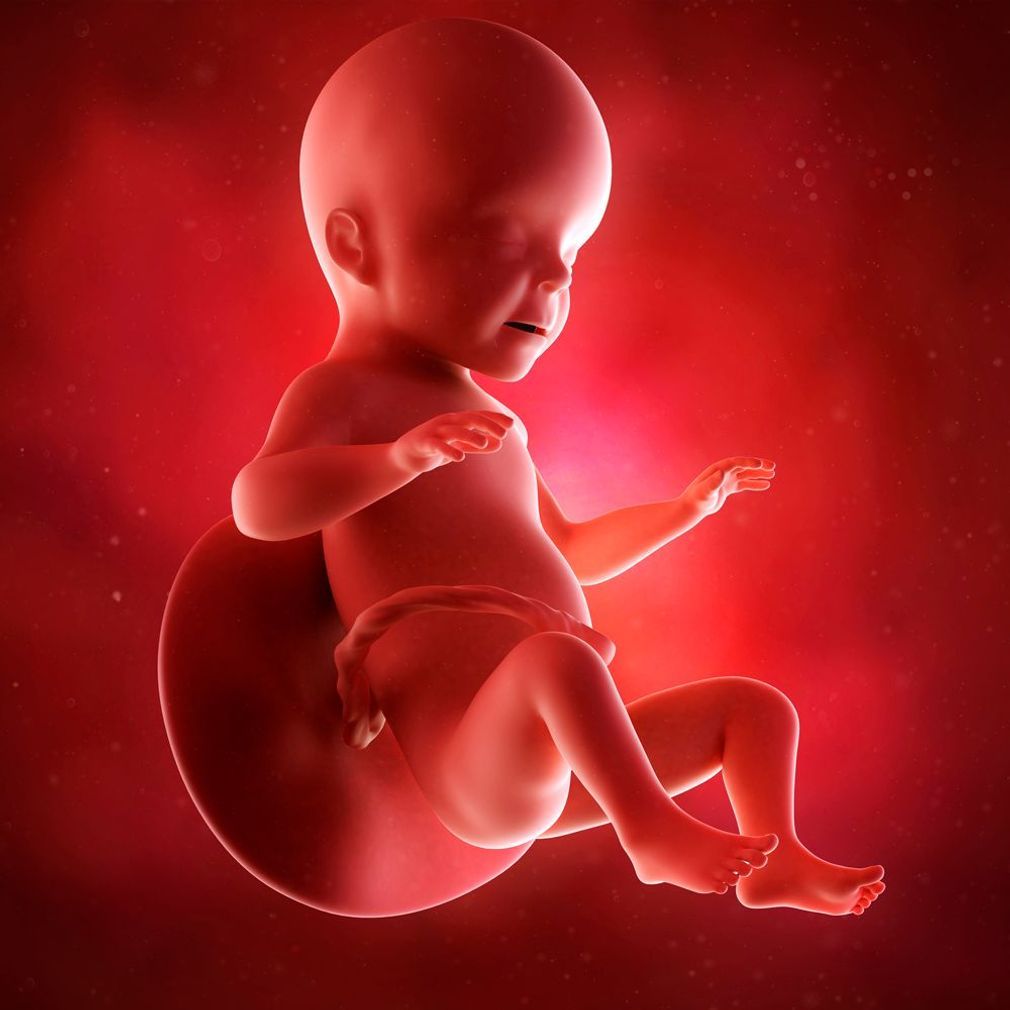
This week, your baby has acquired the reflex to communicate his needs once in the world: crying. His survival depends on it!
His wake-up-sleep rhythm is more regular, but that doesn't mean that it perfectly coincides with yours! Dreaming that he dreamed? Some experts say that at this stage of development, the fetus may already have dreams. Beta or REM brain waves, i. e. fast and of low amplitude, have been detected. They are associated with the REM phase of sleep for you, that is, the phase of sleep where you dream.
His little hands are active because the fetus is working on his dexterity. From time to time, he sucks his thumb. This calms him down and allows him to tone the muscles of his jaw and cheeks.
Blood vessels now flow into the lungs that are not yet mature. His bones are also stronger. If born this week, the baby would still need significant medical support to ensure his or her survival. The baby would still be considered as extreme preemie.

Your future baby is getting more and more beautiful: he is chubbier and his skin is unfolding. It is also redder because of the multiple small blood vessels that pass through it. Under his skin, fat reserves are now higher; they represent about 3% of his total weight.
Gradually, the placenta becomes less important as a nurturing source. The amount of amniotic fluid decreases: the fetus occupies much more space. He also improves his swallowing and suction reflexes.
He is curious: when a light or a sound intrigues him, he turns his head in its direction.
The liver and the spleen work well: they produce a large quantity of blood cells.
The fetus continues to gain a lot of weight. It measures about 25 cm from the head to the coccyx and weighs almost 1 kg.

The baby is still growing. He is wide awake and reacts to noises and caresses on his stomach. He's preparing for the big day. His lungs continue to grow to be ready to take their first breath of air at birth. In the long term, he will weigh 3 to 4 kilograms and measure nearly 50 cm. Here are the last steps of his development.
At the beginning of the 3rd trimester, her digestive system is functional. He continues to drink a lot of amniotic fluid and saves a whole range of flavors thanks to your diet! In addition, the odorous substances carried by the amniotic fluid provide a first olfactory experience that can influence his or her preferences after birth.
At this stage of his development, his bones are fully developed, but they are still soft. His muscles are getting bigger, his eyes are partially open and the eyelashes are formed. His skin becomes smoother.
As he makes a lot of effort, the baby's nutritional needs are very important. He needs a good amount of protein, vitamins, and minerals (especially calcium and iron) that he draws from your diet.
Inside the uterus, the space available to the fetus is limited. His movements become more restricted, which does not prevent him from continuing to push and stretch. And you can feel it!

At this stage, the fetus' eyes are open most of the time. He is even able to see, but his vision remains limited. He can see 20 to 30 cm in front of him. He also perceives noises and voices.
The baby's organs are almost fully formed, except for the kidneys and lungs, which take a bit longer. This is his third pair of kidneys! At the embryonic stage, he has already had two other pairs of kidneys that have disappeared to make way for this new pair, the one he will have for life.
Brain structures are getting stronger. The sheath surrounding the nerve fibers (myelin) continues to grow and this growth will continue intensively during the first years of the baby's life. You will see this through the development of skills such as walking, language, and potty training.
The bone marrow has taken over the liver and spleen to produce red blood cells.
His growth slows down a bit, but he continues to gain weight.
Twenty-eight weeks after fertilization, the fetus measures about 27 cm from the head to the coccyx and weighs nearly 1.3 kilograms. He begins to feel a bit cramped in the womb.

Another step towards the autonomy of your unborn baby: the central nervous system is now able to control the temperature of its body, thanks to the body fat reserves. Besides, the appearance of the fetus has changed: he is rounder!
In his lungs, blood vessels have developed. Breathing movements are becoming more and more regular.
The testicles have now descended into the scrotum. The oocytes - which will become the ovaries - have completed their development. They will "sleep" until puberty, at the onset of menstruation.
Some fetuses already have their heads down. Often, they keep this position until delivery.
Hair and nails continue to grow: you may be surprised at their length at birth.

You feel it shake and make big movements with his arms and legs. From time to time, a wave distorts your whole stomach: he changes his position. Soon, he will be too cramped to do the same thing.
At the end of pregnancy, the fetus gains weight very fast. He gains half his birth weight during the last 7 weeks of pregnancy.
His heart beats at 130 to 140 beats per minute.
He measures 28 cm from the head to the coccyx and weighs 1.7 kilo.

Even if the fetus has much less room to move, you will continue to feel his movements until delivery. As he is curled up (legs folded, arms crossed and chin on the knees), You might feel his movements differently.
His body has the proportions of a newborn (head, body, limbs), but he will take advantage of the next weeks to grow a little longer and, especially, to gain weight.
If it has not already been done, the fetus will turn upside down for delivery. His head will rest on your bones in the pelvis where he will gradually make his way down. At the time of delivery, it will be ensured during your medical visits that the fetus does not turn around.
If he had been born today, the baby would have an average prematurity (this is the most common). His chances of survival would be very good.
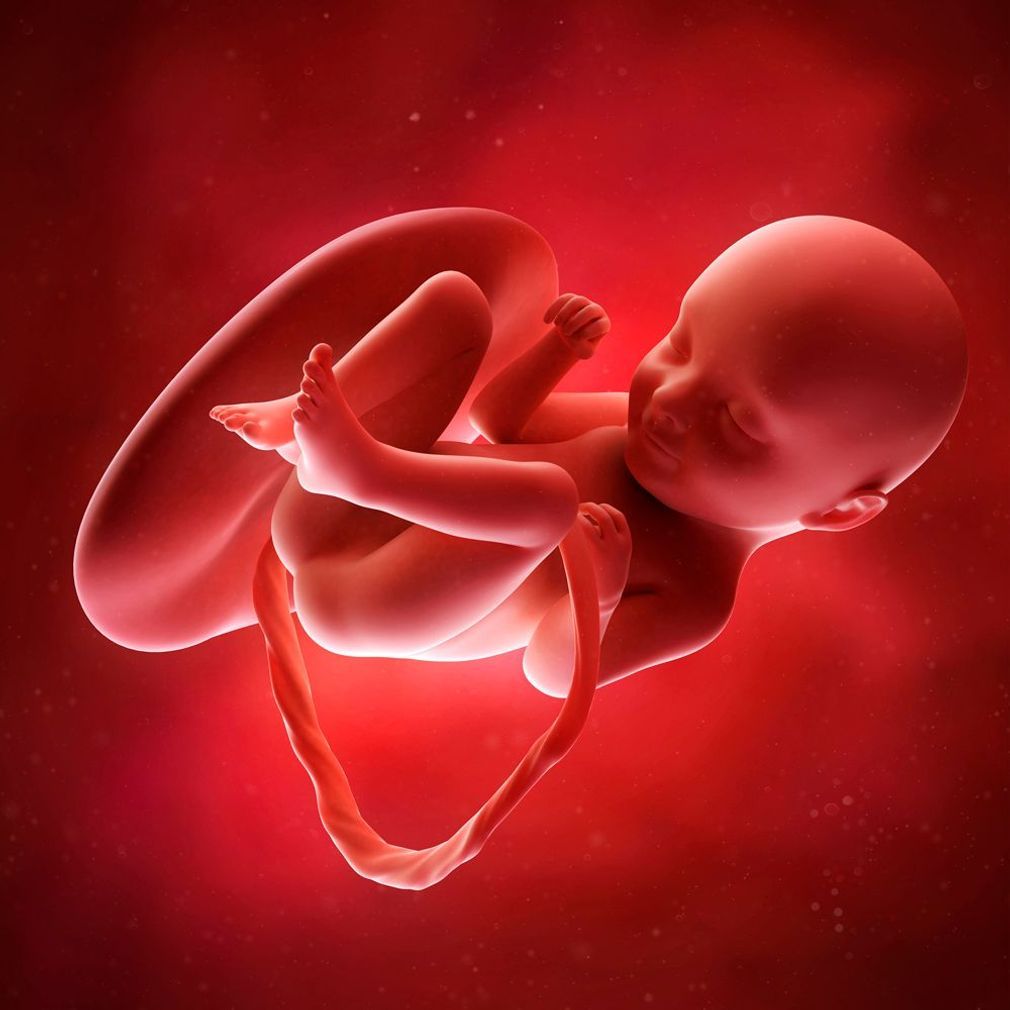
During the last weeks of pregnancy, the fetus swallows a lot of amniotic fluid and pours a good amount of urine (about 2 tablespoons each hour) into the amniotic pouch. The placenta works at full speed to drain and eliminate waste, and your kidneys too! Remember to drink enough water. A simple trick, drink to satisfy your thirst and make sure the color of your urine is not too dark. If you are well hydrated, your urine will be pale yellow.
In his intestines, meconium accumulates. It will be eliminated for the first thing after birth. These are the first stools.
At this point, the majority of organs and systems are now fully functional. Some nevertheless benefit from the last weeks to complete their maturation. This is the case of lungs, bones, skin, nails, and hair.
Bones continue to grow and thicken. The skull bones, however, remain malleable for delivery. They are not welded together. Fontanelles (spaces between the bones) will only close several months after birth.
The placenta brings a lot of calcium to the baby. The baby's calcium level is now higher than that of the mother.
The skin of the fetus has taken a pinkish hue (instead of red). The nails now cover the entire fingertips. Those toe nails, however, take a little longer to grow.
This week, the fetus is about 30 cm from the head to the coccyx.
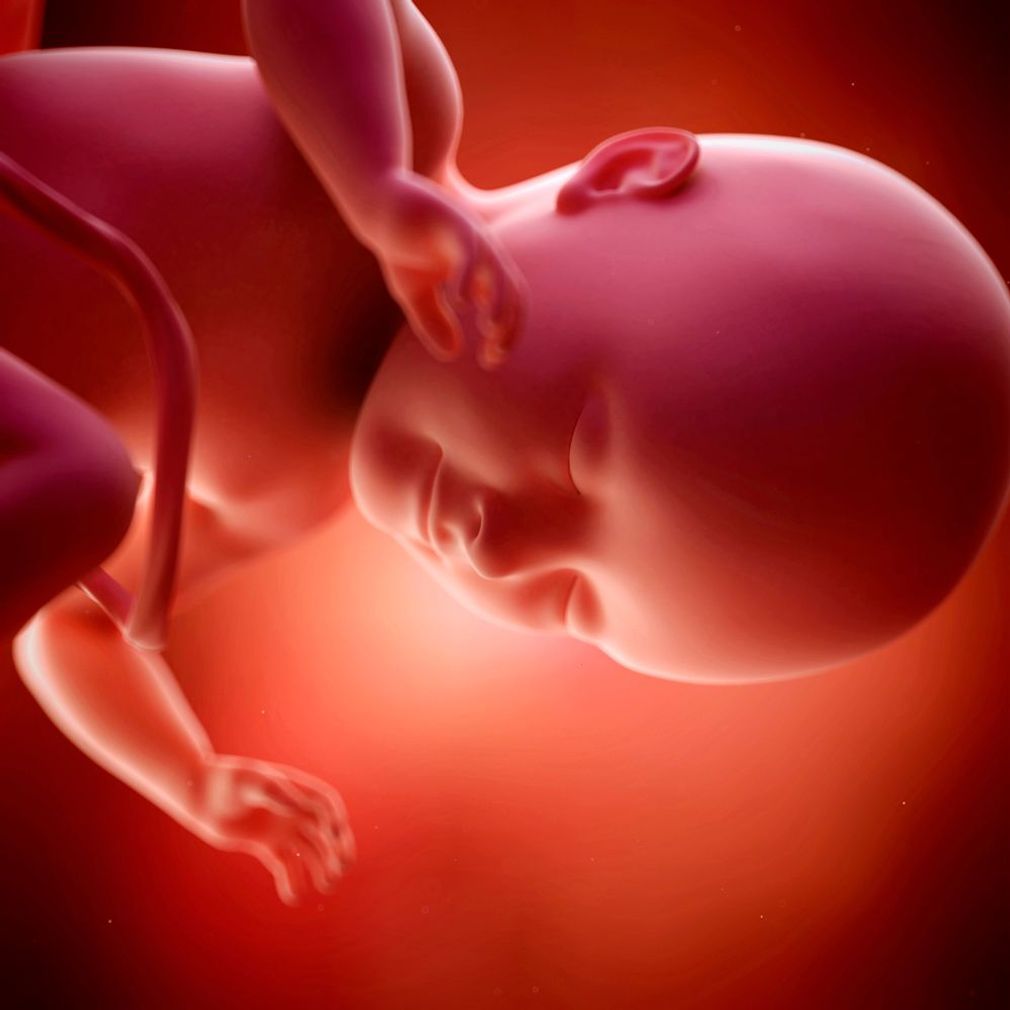
This week marks the beginning of your last month of pregnancy. Two important structures have reached maturity. The brain has completed its fetal development. But it will continue to change throughout life. He keeps a plasticity that allows him to make new learning at any age.
The same goes for your baby's immune system. During pregnancy, he has integrated your antibodies to forge a first immunity. Which will too continue to develop after birth.
The last weeks of gestation are good for the fetus. His digestive system and his lungs are almost mature. In addition, he continues to develop fat reserves for his birth. It will take about 230 g per week in the next month. Now his little limbs are becoming round. Baby is taking his time to look good!
He is more and more cramped. Around him, only one liter of amniotic fluid remains.
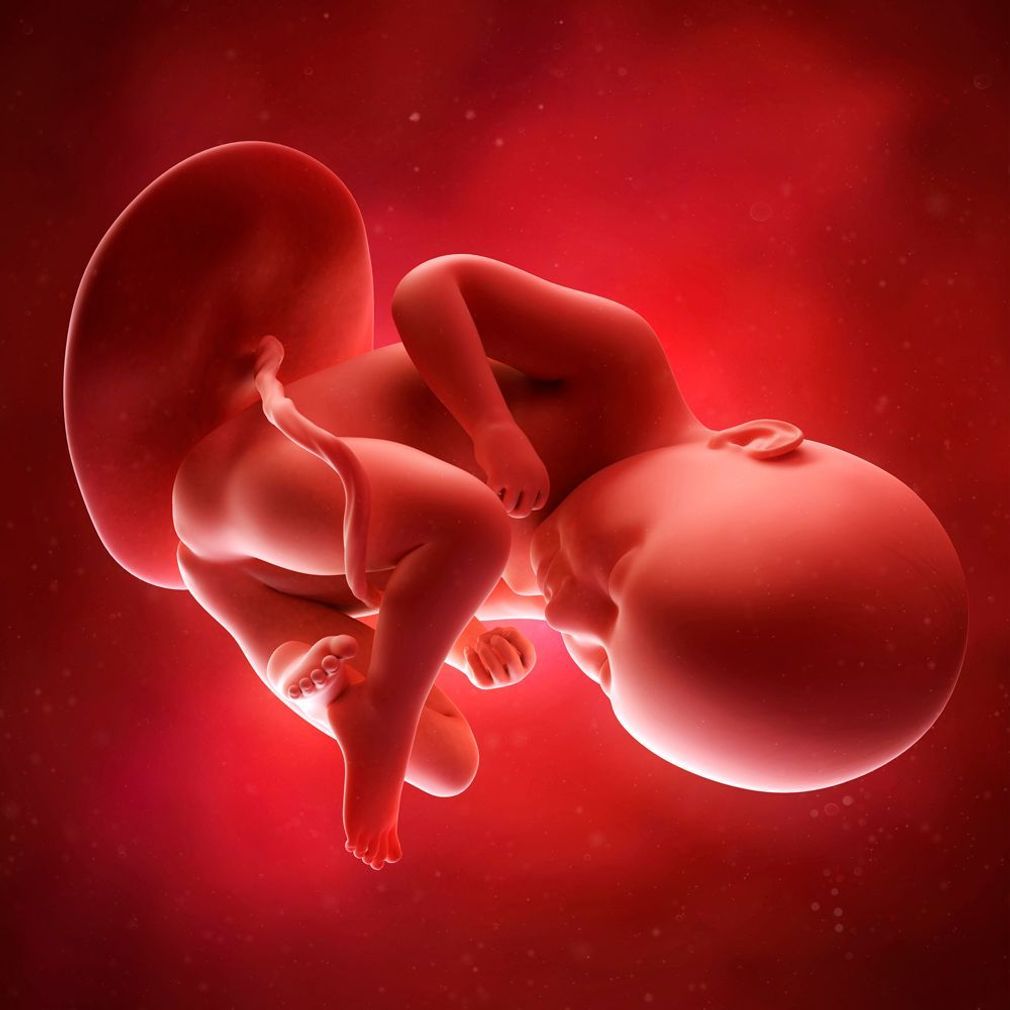
Inspire, expire... Your future baby is training! But he still has hiccups, which is normal. He practices breathing and develops his lungs. But right now, he is breathing amniotic fluid. He swallows at the same time which gives him hiccups. Of all the organs of the body, the lungs take the longest time to develop.
Otherwise, he continues to gain weight. He now has beautiful round cheeks!
In preparation for delivery, he gradually loses what was his protection in the uterus: lanugo and vernix caseosa (viscous substance).

Your future baby is now considered full term. It can happen at any time. All his organs are functional. He has enough strength in himself to survive and start his life as a child.
But only him will decide, in a way, the moment of his birth. When he is too cramped, he will secrete a hormone that will cause contractions. In the meantime, you will surely feel his head getting deeper into the pelvic area (this transition is called lightening). And from time to time, through the tight skin of your belly, a small elbow or heel spring ... You can even recognize the part of his body you see!

Baby is all beautiful! The layer of vernix (the viscous substance that protects the skin from the amniotic fluid) has now detached and floats in the amniotic fluid which is milky in appearance.
The heart is completely ready but will be slightly modified after birth, as some openings between the cavities of the heart are no longer necessary. It is beating harder and the heart rate is slowing down.
His movements are vigorous and the grip reflex is well developed.
Your baby could now weigh about 2.9 kilo.

Your baby sleeps a lot, he is waiting. He has no room to move. His limbs are folded and close to the body, his chin rests on his knees.
Growth is slowing down, but he continues to grow.

All organs are now formed, except the lungs that will finish their development at birth: they will need a few hours to really find the rhythm of breathing. Now, your future baby has all the reflexes necessary to start his development in the outside world. The lanugo falls entirely during this week. His weight should not really change now. Boys tend to be a little bigger than girls at birth, but remember that these are only statistics. Many variations are possible and normal.
It takes a little longer than the expected due date? It is a common situation, especially for the first pregnancy (only 5% of deliveries occur on time). The doctor will discuss with you whether to initiate delivery or not. But certainly, your baby will be here soon!
